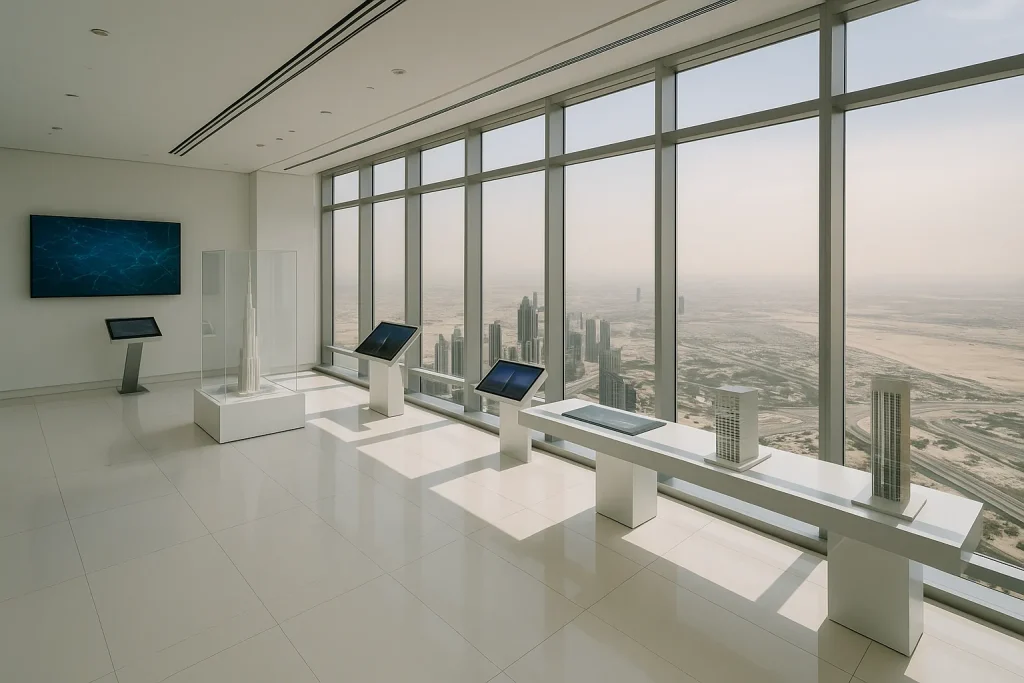Everyone knows the Burj Khalifa for its height. It’s the tallest building in the world, after all. People rush to visit the observation decks, snap some jaw-dropping photos, and maybe grab a coffee while admiring the city sprawling out below them. But there’s a whole other side to the Burj experience that most visitors rush past — the exhibits hidden inside.

These aren’t just filler displays while you wait for the elevator. They’re a real backstage pass into how one of the most ambitious projects in modern history came to life. The sketches, the engineering battles, the human stories — it’s all there, woven into the journey up to the top. If you slow down and really explore, you’ll realize: the view is just the final chapter of a much bigger story.
Architectural Exhibits: Where Big Dreams Started

Right at the start, you’re pulled into the world of design — and it’s pretty mind-blowing. Scale models show what the Burj could’ve been: there are versions that look like crystal spires, others more chunky and muscular.
You realize pretty quickly that the iconic Y-shaped design we know today wasn’t a fluke. It was a choice, shaped by a tug-of-war between beauty and brutal desert winds. The Y-form helps stabilize the tower, channels the wind, and gives residents and visitors sweeping, open views of Dubai.
Seeing the sketches and the evolution of the idea makes you feel like you’re walking through the brain of the architects. It’s the raw creativity before the steel and glass.
Historical Timeline: Building in a Desert, Dreaming in the Sky
The historical exhibits hit differently.
Old photos show the empty desert where the Downtown Dubai we know today didn’t even exist yet. You watch video clips of the first foundation piles getting hammered deep into the sand, cranes swinging against harsh sunrises, and workers in bright vests marching across a dusty, half-built plaza.
There’s a timeline stretching across the walls, tracking every major milestone — and just standing there, you feel the sheer scale of what they accomplished.
Interactive Installations: Touch, Swipe, Feel the Story
Unlike some places where you just stare at glass cases and move on, Burj Khalifa’s exhibits invite you to dive in.
Massive touchscreen panels let you explore details you’d never guess — like how the building’s sway in the wind is carefully calculated, not eliminated. One screen lets you “build” your own tower virtually. Choose the wrong materials, or design a shape that can’t handle the wind shear, and — crash — your virtual skyscraper crumbles.
And then there’s the VR station. Put on a headset, and suddenly you’re standing on a swaying platform, hundreds of meters above the ground. You can almost feel the wind tugging at your jacket.
Engineering Marvels: Solving Problems Nobody Had Solved Before

Here’s the thing: when you stand at the base of the Burj Khalifa looking up, it’s easy to think, “Sure, just build it taller.” But inside, the engineering exhibits explain why it’s way harder than that.
You learn about how the concrete mix had to be invented from scratch — normal concrete would crack under the desert heat. You find out that the cranes had to be custom-built to reach heights no crane had reached before.
Every part of the Burj Khalifa was a puzzle. And walking through the exhibits, you start to realize: this building isn’t just tall. It’s incredibly smart.
The People Behind the Steel and Glass
Maybe the part that hits hardest is the section about the workers.
Thousands of people from dozens of countries spent years piecing together the Burj Khalifa, one grueling shift at a time. Short videos let you hear their voices — not just the engineers in suits, but crane operators, welders, safety officers. One worker described watching every sunrise for two years from 700 meters up. “You stop feeling like you’re building something,” he said. “You feel like you’re living inside it.”
Why It’s Worth Slowing Down for the Exhibits
Look, I get it. You want to race to the top, lean against the glass, snap a photo, and feel that rush of being higher than almost anyone else on earth. But skipping the exhibits means missing the bigger story.
When you understand what it took — the sleepless nights, the breakthroughs, the stubborn belief that this crazy idea could actually work — the view from the top changes completely.
Pro Tips for Enjoying the Exhibits
- Arrive early or go late. Fewer crowds mean you can actually interact with the touchscreens and VR stations without waiting.
- Give yourself breathing room. Planning an extra 45–60 minutes lets you explore without rushing.
- Engage with the displays. Try the virtual building game. Watch the short videos.
- Look beyond the big stuff. Some of the best moments are hidden in small displays.
- Let yourself feel it. Lean into the human side of the story for a deeper experience.
FAQ
Is access to the exhibits included with regular tickets?
Yes, exhibits are part of the experience when you buy tickets to At the Top or At the Top SKY.
How long should I spend exploring the exhibits?
Aim for at least 45 minutes. Longer if you want to fully absorb everything.
Are the exhibits suitable for kids?
Definitely. Between the touchscreens, VR setups, and colorful displays, most kids get hooked pretty fast.
Is there a guided tour option?
Yes. Some packages include guides who share even more stories and behind-the-scenes facts you won’t find on the walls.
Conclusion
The Burj Khalifa is famous because it’s tall. But it’s legendary because of the story it tells — a story of risk, resilience, ambition, and thousands of people from every corner of the world coming together to do something incredible.
The exhibits aren’t just a bonus — they are the heart of the Burj Khalifa experience. So when you visit, take your time. Wander through the models. Watch the videos. Feel the history.
Because seeing the view from the top is unforgettable — but understanding the journey makes it truly unforgettable.
Exhibits Burj Khalifa
